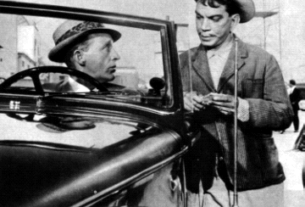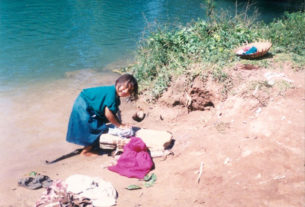Westwords
Ancient American Alexander R. Pembrooke, 84, retired gospel singer, pipe-smoking trout fisherman and stock-market survivor, retains an insatiable appetite for information. He selected our south-of-the-border adventure for 20 Questions, then tacked on “Who is the most famous Mexican?”
My fumbling, bumbling, stumbling answer advertised my weakness in history and made the quiz sound like multiple-choice.
Well, there is famous Mexican lover Speedy Gonzales, I said, trying to dazzle old Alex with distraction. Speedy survived Ted Turner’s sensitivity ban and is back on TV.
Do not overlook Carlos Contreras, first Mexican to race in NASCAR’s Craftsman Truck Series. That was 1999. If you want to be a stickler for details, he finished 14th.
Alex said get serious, so I tried another track. Benito Pablo Juarez, Zapotec Indian, twice president in the middle-late 1800s, is considered Mexico’s Abraham Lincoln. And how about Octavio Paz, poet, author and diplomat, winner of the 1990 Nobel Prize for literature. He wrote 40 or more books and had a thoughtful position on opposites: passion and reason, society and individualism, words and meaning.
Maybe you already know, dear Alex, that Jose Clemente Orozco was a great Mexican muralist, famous for “Man of Fire” still on display at the Cabanas Institute in Guadalajara. Part of Jose’s distinction was a missing hand, a tragedy from a childhood accident with gun powder, later dramatized and attributed to legendary efforts as a revolutionary. When self-promoting gringos try this trick, it is called lying.
A painter with one hand failed to impress Alexander R. Pembrooke. In all his 84 years, he has never seen anybody paint with two hands. So, how about a one-armed sculptor, Jesus Contreras, brilliant artist? That got Pembrooke’s attention. He was pleased to learn that Contreras statues are lined up along Avenida Reforma in Mexico City.
I had finally scored. I poured on the information. Luis Miguel is a magnificent modern Mexican musician who struck it rich when he joined Willie Nelson for a dozen country duets. Lupita Jones was a classic beauty 10 or 15 years ago as Miss Universe. Vicente Fox was a bottoms-up success with Coca-Cola and may yet prove above average as president.
The aged Mr. Pembrooke smiled faintly, said I was smothering him with a smokescreen, and countered with this: “We both know the most famous Mexican is Fernando Valenzuela.”
How could I have been so slow? Fernando Anguamea Valenzuela was a star left-handed pitcher for the Los Angeles Dodgers in 1981, first rookie to win the Cy Young Award. He beat out Tom Seaver, Steve Carlton and Nolan Ryan for that prize.
Valenzuela was the seventh son and last of 12 children born to a humble family, on a farm not as big as a baseball infield, in the tiny village of Etchohauquila in Navojoa, sometime between 1955 and 1960. His official birth date is Nov. 1, 1960, but his sun-baked face always looked older.
Valenzuela had two trademarks. He was shaped like the Pillsbury Doughboy, something like the Yankees’ David Wells before he went on a diet. Fernando had a devastating screwball, maybe as good as the immortal Carl Hubbell’s.
Valenzuela played for Guanajuato and Yucatan before the Dodgers discovered him. He had a fine season in San Antonio before his promotion to Los Angeles. On Opening Day 1981, he was an emergency replacement for scheduled starter Jerry Reuss. He shut out the Houston Astros, 2-0, and that was the start of “Fernandomania”.
It was wonderful. When he pitched, fans streamed into stadiums and were treated to a Mexican fiesta. Fernando rang up eight consecutive victories and paying customers danced in the aisles. His earned run average was 0.80. That April and May, he was baseball’s best player. He became an instant legend in Hispanic communities. He was a media icon. I know. I caught the fever.
It was great theater while it lasted but, alas, Fernando’s fadeaway eventually got hit and he finally lost a game to Philadelphia. So, his rookie season would not be perfect.
Fernando recovered, pitched a record eighth shutout, got his picture on the front of Sports Illustrated and Kellogg’s Corn Flakes, won a game in the World Series and collected a modest $42,500 for a simply sensational season. He finally became a million-dollar-man in ‘83. His top salary was $2,050,000.
Over the years, Valenzuela was a workhorse. His best statistical season was 1986, 21-11 with a 3.14 ERA, National League leader in victories, complete games and innings pitched. In the ’86 All-Star Game, Valenzuela made history by striking out five consecutive American League batters.
The next year was the beginning of the end. He slumped to 14-14. He had arm troubles and won only five games in ‘88. He had one last great moment on June 29, 1990, a no-hitter against the St. Louis Cardinals.
The Dodgers released Fernando the next spring and he returned to the Mexican League. Major league comeback attempts failed until 1996, when he fashioned a fine 13-8 season with the San Diego Padres. Too soon he was gone again.
I caught a glimpse of him last year, in the Mexican Winter League, still hurling at the official age of 41. He looked much the same. Hitters who guessed screwball were just as likely to see a fastball, curve, or change-up, all with the same motion. His windup was the same. He still seemed to ignore hitters and roll his eyes to the heavens.
The memories are awesome. This, dear Alex and my five other friends, was genuine Mexican art.
This summer, Fernando returned to the Dodgers, to pitch words instead of baseballs. He’s in the booth for broadcasts in Spanish. Ah yes, the legend lives on — and what a treat that must be for baseball fans in two countries. I have talked myself into agreeing with the ancient Mr. Pembrooke. Fernando Valenzuela is indeed one very famous Mexican.


